Difficult to Fill Job Openings in 2022
April 28, 2023With rapid job growth in 2021 and 2022, Oregon regained the jobs lost at the onset of the COVID-19 pandemic in March and April 2020. Employers posted more job openings in 2021 and 2022 than we’ve seen since 2013, the start of this survey. They also told us record volumes of job openings were difficult to fill, accounting for 72% of vacancies in 2021 and 2022.
What can employers do to find the workers they need? We looked for signals from our Oregon Job Vacancy Survey, which is designed to identify employers’ vacancies, which ones they have a difficult time filling, and to get a business perspective on why these jobs may be going unfilled. The Employment Department surveyed 16,000 private-sector employers with two or more employees over the course of 2022 and received responses from 4,900, up from the 4,400 businesses who told us about their hiring in 2021.
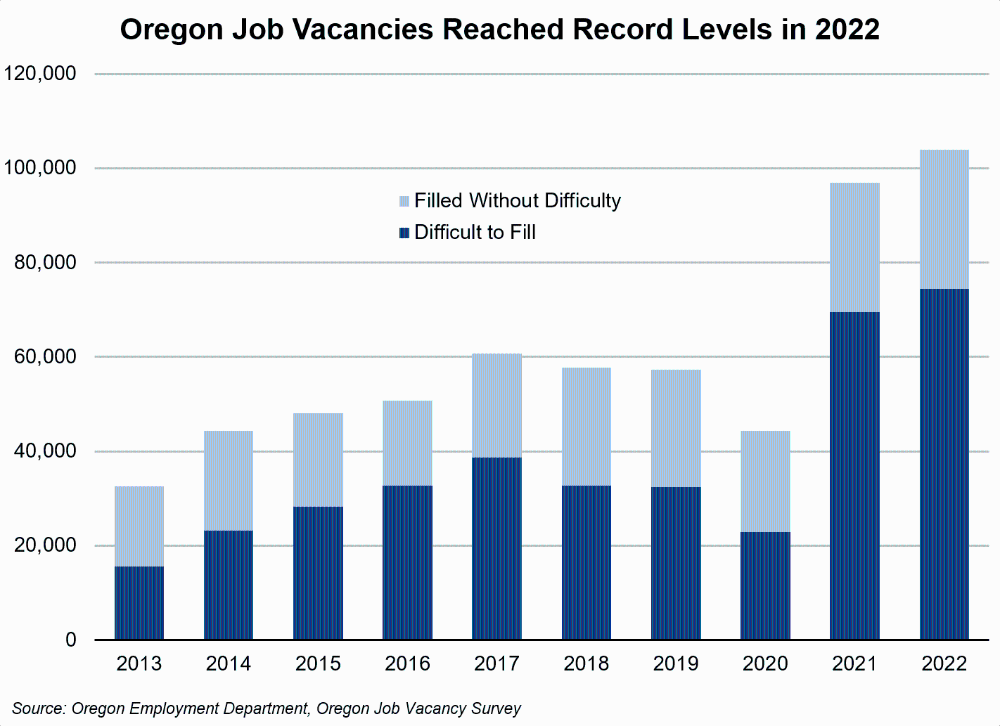
Private employers in Oregon reported about 104,000 job vacancies at any given time in 2022, more than double the vacancies in 2020. Starting wages averaged $21.66. Businesses reported difficulty filling 74,400 of their job vacancies, which accounted for 72% of the total, a jump of 20 percentage points compared with 2020 (51%) and the highest rate since the question was added in 2013. Looking back, the prior peak was 64% in 2016 and 2017 as Oregon’s economic expansion heated up and unemployment rates fell to record lows by the end of 2017. Rapid job growth in 2021 and 2022, as we added back jobs lost to the pandemic, led to a very competitive hiring environment.
Many characteristics of vacancies in 2022 were very similar to past findings. Four out of five job vacancies were for full-time positions, and more than nine out of 10 openings were for permanent positions, regardless of whether or not the vacancy was difficult to fill. Similarly, relatively few hard-to-fill job vacancies (30%) and vacancies filled without difficulty (27%) required education beyond high school.
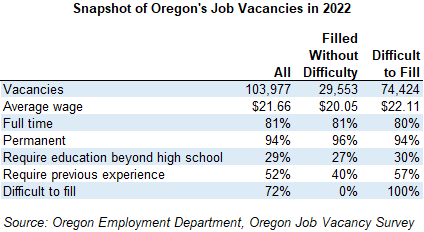
Difficult-to-fill vacancies had two high-level differences in 2022. Firstly, they paid a starting wage that averaged about $2 more per hour than vacancies filled without difficulty. In many cases in 2022, employers were offering higher wages for difficult-to-fill job openings than others in the same occupation. Secondly, difficult-to-fill vacancies were far more likely to require previous work experience (57%) than job openings filled without difficulty (40%). With a record volume of job openings and a limited pool of candidates, employers may have needed to offer higher wages or other benefits to find the experienced candidates they were seeking.
Employers reported difficulty in hiring for 82% of openings that required more than five years of experience, and 78% of vacancies requiring any experience, up to five years of experience. A lower share of vacancies required experience these past two years than prior to the pandemic. The share of vacancies employers reported as having no experience requirement jumped 6 percentage points compared with prior to the pandemic, to 43% in 2022, about the same as the 42% in 2021.
One way to instantly increase your possible pool of applicants as a hiring employer is to reduce the requirements for your job listings – it appears that with the boom in hiring in 2022, employers took notice of that strategy and were less likely to require previous experience. Also, entry-level jobs were more heavily affected by pandemic job losses in 2020, and rapid hiring occurred in 2021 and 2022 to replace those positions.
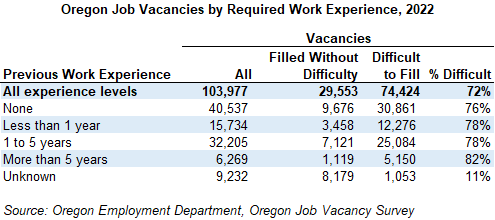
Why Are Job Vacancies Difficult to Fill?
For each difficult-to-fill vacancy, employers offered open-ended responses to identify the primary challenge for the unfilled opening. Their responses were then sorted into 12 categories. Employers indicated that a lack of applicants was the primary factor in more than half of their challenging openings in 2022 (up from 47% in 2021). That’s an unusual finding – the primary reasons for difficulty are usually more spread out among several factors. While the number of job openings reached record highs in 2022, the unemployment rate was historically low through the first half of the year before beginning to rise late in 2022. The number of job openings essentially matched the number of unemployed workers throughout the year. Many positions seem to have gone unnoticed in the swell of opportunities and didn’t receive enough applicants.
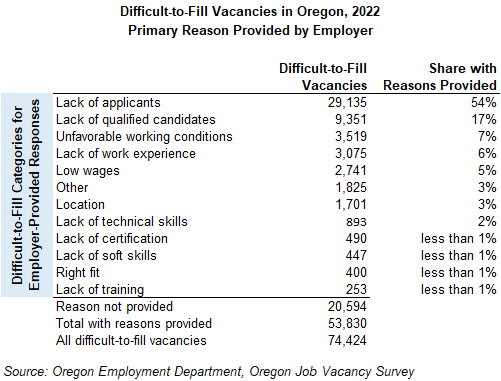
As the economy grew and unemployment rates were low in the years leading up to the pandemic, employers had the most difficulty getting any applications for their job openings at all, similar to their reports in the tight hiring market in 2021 and 2022. The struggle to find candidates with specific qualifications has frequently been among the top three reasons for difficulty, and it was the top reported reason in 2020 at the height of the pandemic. A lack of qualified candidates was the second most prevalent concern in 2022, representing 17% of the difficult-to-fill vacancies.
Another heavily reported reason prior to the pandemic was unfavorable working conditions – like part-time jobs, short hours, nontraditional shifts, and demanding physical labor. Employers reported unfavorable working conditions as their primary concern less frequently than typical in the past two years, accounting for 7% of difficult-to-fill vacancies in 2022 and 5% in 2021.
Vacancies reported as difficult due to low wages dropped considerably in 2022. It came in as the third most reported reason for difficulty in 2021, no doubt driven there by rapid increases in starting wages offered to entice applicants as businesses reopened and worker scarcity became a major dilemma for employers. More business responses acknowledged that their wages weren’t competitive in 2021, accounting for 11% of challenging openings, compared with about 6% in 2017 through 2019. By 2022, employers seemed to feel they’d dealt with the low-wages problem, reporting low wages as the primary reason for 5% of their hard-to-fill vacancies. Indeed, starting wages reported to the survey are up considerably compared with prior to the pandemic.
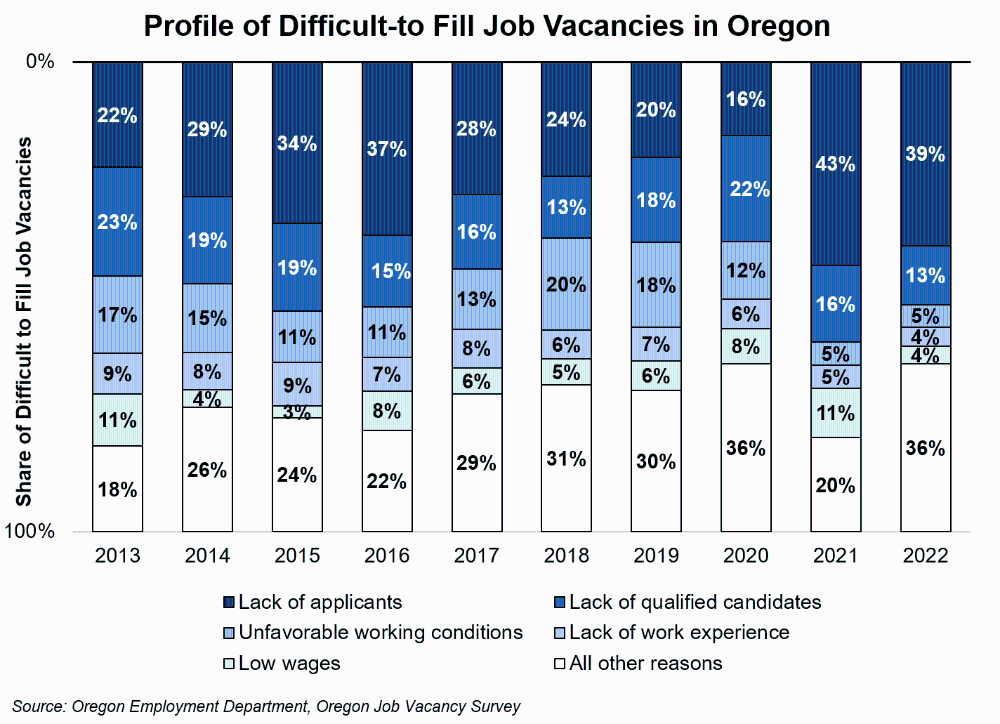
Among 2022 job vacancies where employers reported a lack of applicants, the most common occupations included:
- Restaurant cooks
- Personal care aides
- Nursing assistants
- Stockers and order fillers
- Construction laborers
- Fast food and counter workers
Vacancies that lacked qualified candidates included jobs like:
- Registered nurses
- Heavy and tractor-trailer truck drivers
- Licensed practical and vocational nurses
- Carpenters
- Plumbers, pipefitters, and steamfitters
Top occupations among all the other difficult-to-fill vacancies included:
- Personal care aides
- Retail salespersons
- Nursing assistants
- Maintenance and repair workers, general
- Heavy and tractor-trailer truck drivers
- Restaurant cooks
Overall, employers reported difficult-to-fill job vacancies in 373 different occupations in 2022. The top 15 occupations shown in the table below reflect about one-third of the difficult-to-fill openings in 2022. Occupations with the largest number of hard-to-fill vacancies included personal care aides (2,900), restaurant cooks (2,700), nursing assistants (2,700), heavy and tractor-trailer truck drivers (2,300), and retail salespersons (2,300).
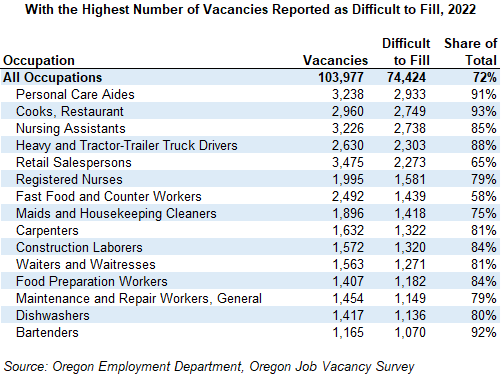
Regions
Difficulty filling jobs hit all areas of the state in 2021 and 2022. Employers reported large shares of hard-to-fill openings in every region. Portland Metro employers reported the least difficulty. Still, nearly two-thirds of openings (65%) in Portland Metro were difficult, and since the area is the largest metro in the state, it accounted for 20,300 hard-to-fill jobs, 27% of the state total. Regions reporting the highest shares of difficult-to-fill vacancies included Northwest Oregon (79%), followed by Eastern Oregon, the Rogue Valley, and Southwestern Oregon (all with a rate of 76%).
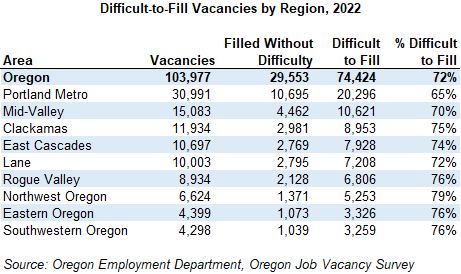
There wasn’t as much variation in average starting wages across the state as one might expect. Average starting wages for hard-to-fill jobs ranged from about $19 per hour in Eastern Oregon to nearly $26 per hour in the Portland Metro region. Portland Metro employers were more often recruiting for jobs that required education beyond high school and previous work experience.
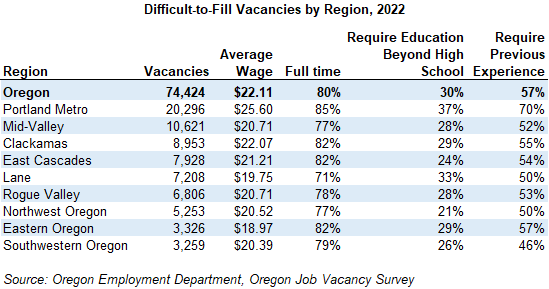
The level of job vacancies in 2021 and 2022 has been above anything we’ve seen since the beginning of this survey in 2013. With many openings and increased difficulty filling jobs in 2021 and 2022, employers may need to consider adjusting their experience and education requirements where possible and providing more training on the job, or they may need to raise the wages (or some combination of pay and perks like benefits or other work flexibility) they offer in order to reach the experienced applicants and qualified candidates they’re seeking.